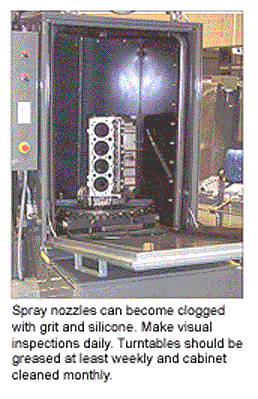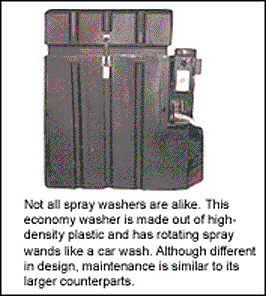In the 2003 Engine Builder Machine Shop Market Profile (Engine Builder, June 2003), shop owners said cleaning/disassembly were their most time consuming parts of the rebuild process. Survey respondents said that 13.8 percent of an average rebuild is spent in this area, down 2 percent from the previous year. In the same survey, 80 percent of machine shops reported owning aqueous jet spray washers. Part of the efficiency increase is likely attributable to the automated jet spray washer and its growing influence in machine shops. But how long those efficiencies will continue may be a question – the survey also pointed out that the average shop’s spray washer is over ten years old.
While the basic design of jet spray washers has not changed much over the last several years, there have been subtle improvements to the equipment. The biggest advances in aqueous cleaning have been on the chemical side of the fence. One factor that has changed over the past few years due to new OHC engine designs is the amount of aluminum now being cleaned. Most chemical manufacturers have kept up-to-date with the industry’s cleaning needs, and new solutions for multi-metal and aluminum cleaning usually include rust inhibitors and silicates to protect iron/aluminum.
A jet spray washer has been called many things: dishwasher, spray cabinet, automated washer cabinet, etc. All these descriptions basically mean that the systems used for washing parts are typically cabinets that you can place parts in, set a timer and walk away. A turntable or rotating spray arm surrounds the parts with an aqueous cleaning chemical solution, rinsing away the dirt and grime from a greasy engine part.
The machines clean the parts, but it is up to you to maintain your machines. So we have put together some tips from various manufacturers to help keep your cleaning equipment in tip-top shape.
Daily Maintenance

It is important to monitor fluid level because evaporation can expose the heating element to air, which can burn it out very quickly. Always remember to check your solution level and concentration in the morning before you start. Many new models have built in alarms that warn you when the solution is too low, but if you don’t have one with an alarm you’ll have to monitor it religiously. Checking the chemical is like checking your pool or hot tub – a simple dip test will tell you the chemical concentration and what the pH level is. If it is lower than optimum you may “sugar” the solution as necessary. Some manufacturers recommend adding a pound or two of powdered chemical a week to compensate for evaporation and diluted chemical charge.
As you clean, the grease and oils emulsify in the heated solution. This doesn’t mean it is gone. The grease is still suspended in the solution and if it’s skimmed or filtered, the chemical lasts longer. It is best to run the skimmer at a time when the solution is the coolest. Depending on how dirty the parts are and how much you clean, you may find it best to do nightly or weekly.
Visually inspect your nozzles for clogging. Just like the inspection your car gets during a lube/oil/filter, you should check your nozzles at the same time that you’re monitoring the fluid level. It’s a good idea to lump several check points into one routine, therefore saving time and 
ensuring everything is checked regularly. If you have a filter you’ll get most of the large debris, but it doesn’t take much to clog a spray nozzle. Nozzles tend to clog with large chunks of debris (e.g., silicon, paint chips or metal). Without inspecting them frequently, you may not know if one is clogged because the solution will bypass the clogged one for the next open nozzle.
Watch your temperature. Most machines have seven-day timers and a digital or analog temperature controller. This doesn’t mean they’re foolproof. In the morning when checking the charge, dip a thermometer to see that the solution is actually the temperature the thermostat says.
Seven-day timers can be set to bring the bath up to operating temperature before the workday begins and automatically shut it off at some point during the evening. Jet spray washers typically work best when the chemical is heated to a range between 140













